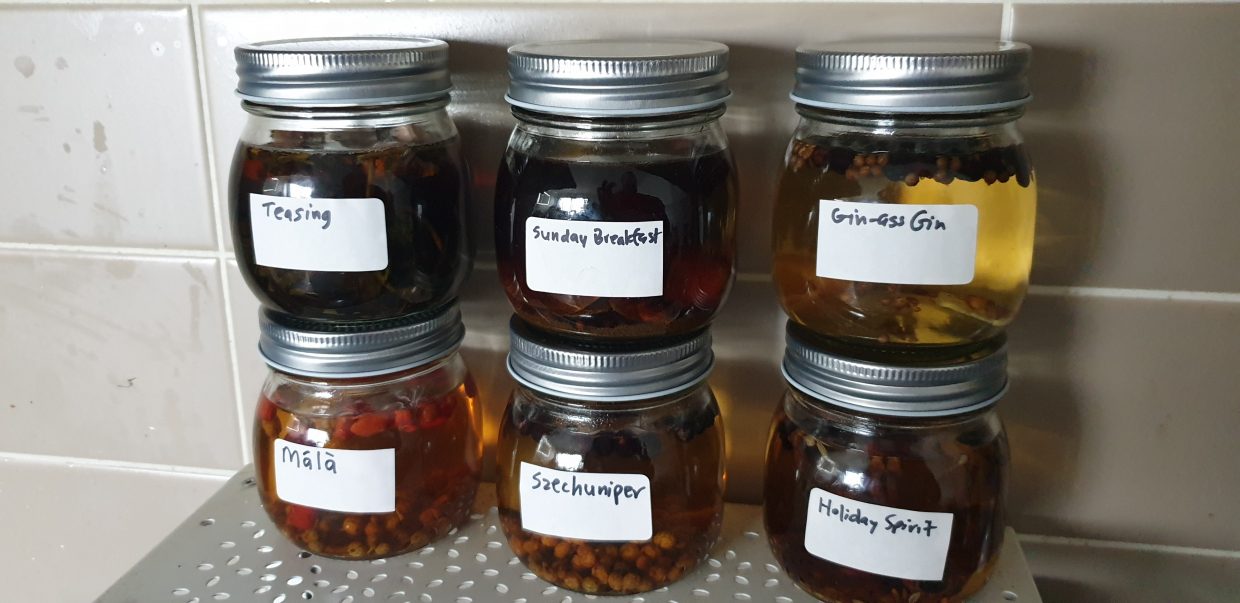
Infusions: Batch 4 tasting
Batch 4 of my vodka infusions was overall a successful batch. I evolved a few of the concepts from previous batches, while others I just tried to replicate while being more intentional with amounts (and taking better notes!)
The two stand-out infusions from this batch were:
- Sunday Breakfast: The most “marketable” infusion, with a marmalade taste, nice straight or with a sweet tonic.
- Má là: The most different and interesting infusion, with an adventurous journey of a drinking experience, combining the bite of chilli and the buzz of Szechuan peppers.
Teas-ing
Oolong, jasmine, mystery tea (also oolong), rose buds
Aim: Lots of tea.
This was an evolution of a previous infusion with tea and Szechuan pepper. Tasters of the previous infusion had said it reminded them of a nice Chinese tea.
Tasting: Mostly oolong tea. The rose buds did provide a floral note on the nose, but in terms of taste it was mostly oolong. I’m not sure this one had enough going for it to justify doing it again.
Lessons: Do I really want this much tea? This might come back as an element of something else, like if I want to add the floral scent of rose.

Sunday Breakfast
Grapefruit, orange, lemon, lime peel, the contents of a Yorkshire tea bag, toasted walnuts
Aim: I initially wanted to make a marmalade infusion, using mostly a mix of citrus peels, but then thought I’d expand it to include tea and toast for a full Sunday breakfast.
For the tea I emptied an entire Yorkshire Tea bag into the infusion. I was a bit worried this would overpower the rest of the infusion, possibly bringing out the tannin flavour of over-steeped tea.
For the taste of toast, I tried toasting some chopped walnuts in a small pan.
Tasting: I’m not sure the tea and the walnuts really came through in the end, but it did have a very citrusy marmalade taste when combined with sugar syrup and a little bit of cold water. A success at least on that front.
This one proved popular with other tasters, mixing with tonic for a bit of sweetness to really draw out the marmalade flavours. Probably the most easily marketable of this batch, although that’s not surprising.
I made this infusion mostly because I thought my father would enjoy it, and it appeared that he did! He drank it as a sipping drink.
Lessons: In retrospect, it could have been useful to start with a citrus infusion and a separate tea and toast infusion, with a combination of the two, to attempt to figure out what each element brings to the drink. As it is I’m not sure whether the tea and walnuts added anything.
Avenues for exploration: I’d also like to try this one without the tea and walnuts for comparison. It’s difficult to taste what those elements bring to the drink without a comparison point.
I’d like to try a version with a different source for the toast taste, perhaps sesame seeds or something related to bread.
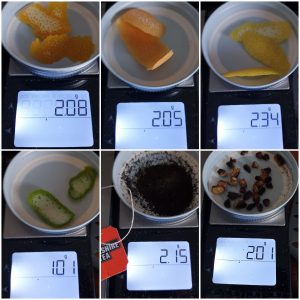
Gin-ass Gin #2
Juniper, coriander seeds, grapefruit peel, angelica root
Aim: To make some gin. I added angelica root (only .5g), which is often used as a fixative in gins. I also switched out the lime from the previous gin-ass gin for grapefruit, as the lime dominated in the previous version, and I hoped grapefruit would be a more subtle citrus.
Tasting: The angelica root seemed to become the dominant flavour this time. It wasn’t a bad flavour, but it steered the gin more towards savoury.
I got good feedback from this gin, and drinking it with tonic transformed some of the savoury nature of the angelica root into a secondary element of the sweetness of the tonic.
Lessons: I think I need to figure out the angelica root. In other recipes I have seen orris root used, but angelica was what I could find. Perhaps it’s just a matter of reducing the amount even further, or increasing the strength of the other elements.
The grapefruit worked well as a citrus this time, becoming part of the overall flavour profile, rather than the dominant flavour.
Avenues for exploration: I need to figure out how to increase the juniper flavour if I want this to be a proper gin. This could involve increasing the amount of juniper in the mix, or breaking down the berries a bit before infusion.
I’ll try reducing the angelica root in the next version of gin-ass gin. I’ll also add cardamom, and maybe a few other bits and pieces.
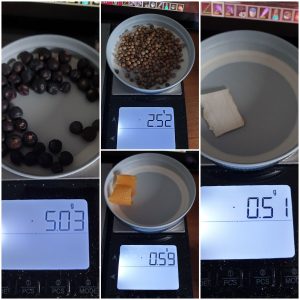
Má là
Szechuan pepper, chilli pepper, Goji berry
Aim: I was hoping for an intense drinking experience (the buzz of Szechuan pepper and the bite of chilli pepper), matched with a gentle, complex and pleasant taste, combining savoury elements with fruity sweet elements.
Tasting: Certainly an experience! Sipping this left both a buzzing and a chilli bite. The goji berry gave the Szechuan and chilli peppers a round fruity flavour to cling to.
This one received good feedback from tasters who enjoyed the lingering sensation of Szechuan pepper. It also worked well added to lemonade to give a light herbal taste and Szechuan pepper buzz to the drink, without overwhelming it.
My most memorable taste of this was sipping it with some ice. The flavour seemed to evolve as more of the ice melted into the drink, and my mouth got used to the various sensations.
Lessons: The goji berry didn’t stand out much in this drink, although it did potentially perform well as a third flavour to balance out the Szechuan and chilli peppers.
For me a focus of this drink was the physical experience of drinking it. I was concerned the chilli would add too much of a bite, overpowering the other elements, but it just added an initial sting, almost acting as a warning of the slower building Szechuan buzz.
There is something to be said for the layers coming in at different times. The chilli sting comes in first, and then fades out to allow space for the sweet goji berry, which then gives way to the longer lasting Szechuan pepper buzz. Even then, a minute or so after the first sip, you start to notice the signature lingering salty herby taste of Szechuan peppers. If I add more botanicals, I’ll have to be mindful of where in the sequence they will appear.
Avenues for exploration: I’d like to experiment a bit with adding other flavours, without overpowering the Szechuan/chilli focus. It could be interesting to combine this with the Sunday Breakfast infusion (maybe 4:1, so the Sunday Breakfast is more of a background note).
I could also explore adding some more spices associated with má là cooking (cloves, star anise, cinnamon), although I’d need to be careful not to overpower the Szechuan pepper and chilli. A colleague is interested in pairing this with a lime and salt syrup, which could add further complexity.
One concern about this infusion is whether it holds the flavours and effects over a long time. Having tried angelica root in the gin-ass gin, I’m curious if it might help in this one. The savoury, herbal taste of angelica root would possibly work well in this infusion as well, matching with the Szechuan pepper notes.
Overall though, I think this drink was the most interesting of the batch.

Szechuaniper
Szechuan pepper, juniper berry
Aim: This one was mostly an attempt to recreate the Szechuan/juniper combination from the previous batch, but this time with more precision and recording of amounts.
Tasting: As expected, this does capture the Szechuan pepper taste and tongue-buzz. Again, I’m not sure how much the juniper berries are bringing to the equation.
Lessons: I think if I’m going to continue a line of tests with Szechuan pepper without the chilli, I’ll try to take it in a different direction to the Ma La. Perhaps I could aim for a subtler Szechuan pepper buzz, secondary to a primary botanical flavour.
I did a tour and tasting at Big River Distilling Co, a small distillery focusing on gin, and I didn’t realise until I went there that one of this distillery’s gins uses Szechuan pepper (secondary to mandarin).
Avenues for exploration: If I want to continue with the juniper Szechuan pepper combination, I will need to increase the influence of the juniper.
Perhaps a Szechuan pepper juniper combination could be explored more once I’ve solidified my gin-ass gin recipe.
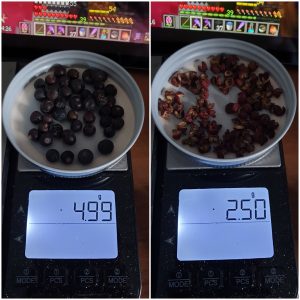
Holiday Spirit
Star anise, cloves, cinnamon, fennel, orange peel
Aim: Christmas!
Tasting: I’m not sure this one turned out quite as interesting as I had hoped. It tasted mostly of cloves and star anise/fennel. Not bad, but I suspect it’s a well-worn concept.
It could be quite interesting as an ingredient in a drink, as it really does bring the taste and smell of Christmas spices. I don’t think the cinnamon really came through, although it was pretty old (from a jar on my spice rack) so perhaps I should have used newer cinnamon.
This worked best in tasting as an addition to another drink, like tonic or lemonade. Some tasters mostly tasted the anise flavour, others mostly tasted cloves.
Lessons: This one was pretty much successful, although it doesn’t feel like an exciting breakthrough. The lesson might be that star anise and fennel are quite strong botanicals, so I should be careful when adding them to an infusion where they aren’t the main flavour I’m going for.
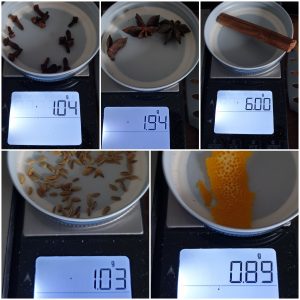
Batch 5 – looking forward
I’m most excited to explore the Ma La concept in the next batch. I think I’ll fork it though, as there are two paths I’d like to explore: straight Má là (perhaps for combining with other infusions), and Malajiang (trying to capture the spice combination of Szechuan cooking sauce.
I’ll also split the Sunday Breakfast in two. First with a marmalade infusion to isolate the citrus tastes, in order to figure out what (if anything) the walnut and tea added to Sunday Breakfast. And Secondly an evolution of Sunday Breakfast, trying other seeds and nuts to bring out the toast flavour.
I’ll continue the Gin-ass Gin line, adding some more standard gin botanicals, and trying to reduce the angelica root influence.
Finally, I’d like to try something new. I’m not sure what yet. Perhaps something along the lines of lemon and ginger? Or a fruity infusion left for longer? Perhaps I could see what black pepper does in an infusion.
I haven’t experimented much with leaving botanicals for different periods of time (e.g. putting juniper in for a week, and putting Szechuan pepper in for just the last day), but I think that will be something I can fine tune once I’ve got some more defined botanical combinations.
Batch 5 may include:
- Má là 2 (stronger goji? A hint of lime? angelica root as a fixative?)
- Malajiang (Má là with additional spices)
- Marmalade (Sunday Breakfast without the tea and toasted walnuts)
- Sunday Breakfast 2 (Trying different toasted seeds and nuts)
- Gin-ass Gin 3 (less angelica, stronger juniper, add cardamom)
- A sixth, new concept (I’m not sure why I feel the need to do six, but it seems important). Perhaps a fruity, longer term infusion?